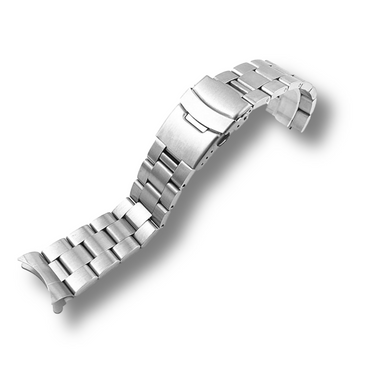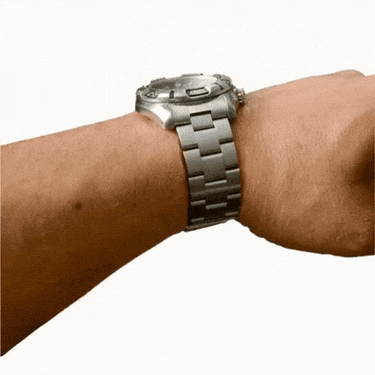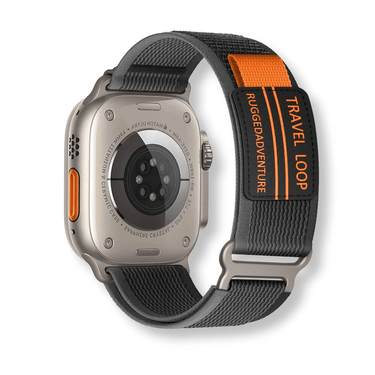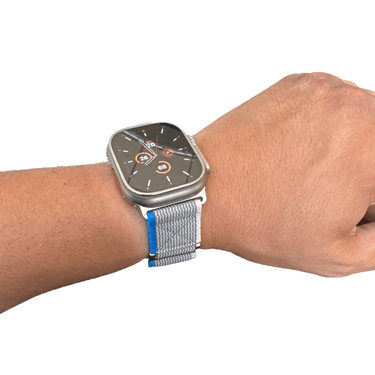Biodegradable watchbands have gained traction in the fashion industry as consumers become more conscious about the environmental impact of their choices. These watchbands are made from eco-friendly materials such as recycled plastic bottles, cork, and organic cotton. They are designed to minimize harm to the planet during production and disposal. The rise of biodegradable watchbands reflects the growing demand for sustainable fashion and the industry's response to consumer preferences.
Key Takeaways:
- Biodegradable watchbands are made from eco-friendly materials and minimize harm to the environment.
- They reflect the growing demand for sustainable fashion and the industry's response to consumer preferences.
- Recycled plastic bottles, cork, and organic cotton are commonly used materials for biodegradable watchbands.
- Choosing biodegradable watchbands contributes to environmental conservation and supports ethical manufacturing.
- The rise of biodegradable watchbands showcases the fashion industry's commitment to greener alternatives.
The Importance of Sustainable Fashion
The fashion industry plays a significant role in environmental degradation, contributing to pollution, waste, and climate change. Adopting sustainable practices is crucial to mitigate these negative impacts and create a more eco-friendly industry. Sustainable fashion aims to minimize environmental harm through the use of eco-friendly materials, reduction of waste, and ethical manufacturing processes.
By choosing sustainable fashion, consumers can actively contribute to environmental conservation. Opting for eco-friendly watchbands, such as biodegradable options, helps reduce waste and carbon emissions. Additionally, sustainable watchbands are often produced using renewable energy sources and recycled materials, further minimizing their environmental footprint.
"Sustainable fashion aims to minimize environmental harm through the use of eco-friendly materials, reduction of waste, and ethical manufacturing processes."
Embracing sustainable fashion not only benefits the environment but also promotes ethical labor practices. Many brands producing sustainable watchbands prioritize fair trade and ensure the well-being of their workers. By supporting these brands, consumers can make a positive impact on both the planet and the lives of individuals involved in the fashion industry.
The Environmental Impact of Traditional Watchbands
Traditional watchbands, made from materials such as leather, rubber, or metal, have significant environmental consequences. Leather production requires vast amounts of land for grazing, leading to deforestation and habitat destruction. The tanning process also involves the use of chemicals that pollute water sources.
Rubber watchbands, commonly made from synthetic materials like silicones, contribute to deforestation due to the establishment of monoculture rubber plantations. These plantations often replace native forests, impacting biodiversity and ecosystem stability. Metal watchbands, on the other hand, require mining activities that result in deforestation, soil erosion, and water pollution.
By understanding the environmental impact of traditional watchbands, consumers can make informed choices to support sustainable alternatives and contribute to a more eco-friendly fashion industry.
| Traditional Watchbands | Sustainable Watchbands |
|---|---|
| Leather production involves deforestation and water pollution | Biodegradable watchbands made from eco-friendly materials |
| Rubber watchbands contribute to deforestation and impact biodiversity | Sustainable watchbands made from recycled materials |
| Metal watchbands require mining activities that lead to deforestation and water pollution | Ethically manufactured watchbands with minimal environmental impact |
A Brief Overview of Sustainable Watchbands
Sustainable watchbands are an essential component of the growing sustainable fashion movement. These watchbands are crafted from eco-friendly materials, harnessing the power of nature to create stylish accessories that leave a minimal environmental footprint. By opting for sustainable watchbands, consumers can make a positive impact on the planet while still expressing their personal style.
There is a wide range of eco-friendly materials used in the production of sustainable watchbands. Recycled plastic bottles, cork, and organic cotton are just a few examples of the innovative materials employed to create these environmentally conscious accessories. These materials not only reduce waste and harmful emissions but also provide a more ethical alternative to traditional watchbands made from leather or metal.
Furthermore, sustainable watchbands are designed with the principles of circularity and longevity in mind. They are constructed to withstand everyday wear and tear, ensuring durability and longevity. This not only reduces the overall environmental impact but also saves consumers money in the long run as they won't need to replace their watchbands as frequently.
By embracing sustainable watchbands, consumers can actively participate in the fashion industry's shift towards more eco-friendly practices. Supporting brands that prioritize sustainable materials and ethical manufacturing processes sends a powerful message that consumers demand greener alternatives. Together, we can make a significant impact on reducing the environmental footprint of the fashion industry and pave the way towards a more sustainable future.
| Benefits of Sustainable Watchbands |
|---|
| Reduces waste and harmful emissions |
| Utilizes eco-friendly materials like recycled plastic bottles and organic cotton |
| Provides an ethical alternative to traditional watchbands made from leather or metal |
| Promotes circularity and longevity through durable construction |
| Supports the shift towards more sustainable practices in the fashion industry |
The Environmental Impact of Traditional Watchbands
Traditional watchbands made from materials such as leather, rubber, or metal have a significant environmental impact. Leather production, for instance, requires land for grazing and water for tanning, contributing to deforestation and water pollution. Rubber production involves monoculture plantations, which displace native forests and impact biodiversity. Metal watchbands require mining activities that lead to deforestation, soil erosion, and water pollution. Additionally, the production process of traditional watchbands involves the use of chemicals that harm the environment.
The table below highlights the environmental impact of traditional watchbands compared to sustainable alternatives:
| Material | Environmental Impact |
|---|---|
| Leather | Contributes to deforestation, water pollution, and excessive resource use |
| Rubber | Displaces native forests, impacts biodiversity, and involves monoculture plantations |
| Metal | Causes deforestation, soil erosion, water pollution, and requires mining activities |
It is evident that traditional watchbands have a significant negative impact on the environment throughout their lifecycle, from production to disposal. The extraction of raw materials, manufacturing processes, and waste generated all contribute to pollution, resource depletion, and habitat destruction. As consumers become more aware of these environmental consequences, there is a growing demand for sustainable alternatives that minimize harm to the planet.
The Emergence of Sustainable Watchbands
Sustainable watchbands have emerged as a popular trend in the fashion industry, offering a more eco-friendly and ethical alternative to traditional watchbands. These watchbands are made from a variety of sustainable materials, such as recycled plastic, cork, and organic cotton. They are produced using ethical manufacturing processes, including the use of renewable energy sources and water recycling.
By supporting brands that produce sustainable watchbands, consumers play a crucial role in fostering a more sustainable fashion industry. These watchbands promote ethical manufacturing practices, reduce waste, and encourage the use of eco-friendly materials. Supporting sustainable watchbands not only benefits the environment but also contributes to the well-being of workers involved in the production process.
Furthermore, sustainable watchbands are available in various styles, catering to different fashion preferences. Whether you prefer a casual rubber band or a fancy leather strap, there are sustainable options to choose from. The emergence of sustainable watchbands reflects the industry's response to consumer demand for greener alternatives and highlights the growing importance of sustainability in fashion.
The Benefits of Sustainable Watchbands
Sustainable watchbands offer numerous benefits. By opting for biodegradable watchbands, individuals contribute to the reduction of waste, carbon emissions, and water pollution. These watchbands promote environmental conservation and provide a more ethical alternative to traditional watchbands. Additionally, sustainable watchband production often involves fair labor practices, ensuring the well-being of workers involved in the manufacturing process.
A Call To Action
As consumers, we have a responsibility to make conscious choices that contribute to a more sustainable fashion industry. By supporting brands that prioritize sustainability, we send a message that eco-friendly practices and ethical labor standards are important to us. One simple way to make a difference is by opting for sustainable watchbands.
Choosing biodegradable or vegan watchbands made from eco-friendly materials such as recycled plastic, cork, or organic cotton can have a meaningful impact on reducing the environmental footprint of the fashion industry. These watchbands not only minimize waste and carbon emissions but also support ethical manufacturing practices.
Let's use our purchasing power to support brands that align with our values and promote sustainable fashion. By making the switch to sustainable watchbands, we contribute to environmental conservation and encourage the industry to prioritize ethical alternatives.
What You Can Do:
- Research brands that offer sustainable watchbands and choose products made from eco-friendly materials.
- Spread awareness about the importance of sustainable fashion and encourage others to make conscious choices.
- Support local artisans and independent brands that prioritize sustainability and fair labor practices.
- Consider the lifespan of your watchbands and opt for high-quality, durable options that can be repaired or reused.
"The future of fashion lies in sustainable choices. By opting for eco-friendly watchbands, we can contribute to a greener and more ethical industry." - Fashion influencer, Sarah Green
Together, we can make a difference and drive positive change in the fashion industry. Let's embrace sustainable watchbands and take responsibility for the impact of our fashion choices on the environment.
The Benefits of Sustainable Watchbands
Sustainable watchbands offer numerous benefits, not only for the environment but also for consumers who prioritize ethical alternatives. By choosing biodegradable watchbands, individuals contribute to environmental conservation by reducing waste, carbon emissions, and water pollution. These eco-friendly watchbands are made from materials like recycled plastic, cork, or organic cotton, ensuring a minimal environmental impact from production to disposal.
Furthermore, sustainable watchband production often involves fair labor practices, ensuring the well-being of workers involved in the manufacturing process. By supporting brands that prioritize sustainability, consumers can feel confident that their purchase aligns with their values and supports ethical manufacturing.
"Sustainable watchbands are a small but significant step towards creating a more sustainable and ethical fashion industry. By opting for these eco-friendly alternatives, consumers are making a positive impact and encouraging the industry to adopt more sustainable practices."
Additionally, sustainable watchbands offer diverse style options, from casual rubber bands to elegant leather straps. This allows consumers to express their fashion preferences while still making eco-conscious choices.
Table: A Comparison of Traditional and Sustainable Watchbands
| Traditional Watchbands | Sustainable Watchbands | |
|---|---|---|
| Materials | Leather, rubber, or metal | Recycled plastic, cork, organic cotton |
| Environmental Impact | Deforestation, water pollution, soil erosion | Reduced waste, carbon emissions, water pollution |
| Labor Practices | Varies, may involve unethical practices | Fair labor practices, supporting ethical manufacturing |
| Style Options | Limited variety | Diverse range to suit different fashion preferences |
As seen in the comparison table above, sustainable watchbands offer a more environmentally conscious and ethical alternative to traditional watchbands. By choosing sustainable watchbands, consumers can prioritize both style and sustainability, making a positive impact on the fashion industry and the planet.
The Rise of Vegan Watchbands in Fashion
The fashion industry has witnessed a rise in the popularity of vegan watchbands, offering an eco-friendly alternative to traditional animal-based materials. These watchbands are made from synthetic materials like cork or pineapple leather, aligning with sustainable fashion principles. With the growing demand for cruelty-free and environmentally conscious products, many popular watch brands have already incorporated vegan watchbands into their collections.
Vegan watchbands support the ethos of sustainable fashion, which aims to minimize environmental impact and promote ethical alternatives. By opting for vegan watchbands, consumers contribute to reducing the demand for animal-derived materials and the negative ecological consequences associated with their production. Moreover, these watchbands offer an opportunity to take part in the ongoing movement towards a more conscious and sustainable fashion industry.
When it comes to sustainability, vegan watchbands offer several advantages. They help conserve natural resources by reducing the need for animal farming or mining for materials like leather or metals. Additionally, vegan watchbands often involve the use of recycled or upcycled materials, further reducing waste and promoting a circular economy. By embracing vegan watchbands, fashion enthusiasts can make a positive impact on the environment without compromising on style.
In conclusion, the rise of vegan watchbands in the fashion industry reflects the growing demand for sustainable and cruelty-free alternatives. These watchbands are made from synthetic materials, such as cork or pineapple leather, and offer an eco-friendly option to traditional animal-based watchbands. Vegan watchbands align with the principles of sustainable fashion, contribute to environmental conservation, and promote ethical manufacturing practices. By choosing vegan watchbands, consumers can make a fashion statement that is not only stylish but also in harmony with their values.
The Problem with Traditional Watchbands
Traditional watchbands made from materials like leather or metal have a significant environmental impact. Leather production involves the use of harsh chemicals and excessive resources, contributing to water pollution and deforestation. Metal watchbands require mining operations that lead to deforestation and pollution. Furthermore, both types of watchbands contribute to waste and disposal issues, as they often have a limited lifespan.
"The production of leather watchbands involves harmful chemicals and a significant amount of water usage, which contributes to water pollution and deforestation." - Environmental Watch Group
In addition to the environmental impact, traditional watchbands also have ethical concerns. Leather watchbands involve the use of animal products, which raises questions about animal welfare. Furthermore, the mining of metals for watchbands often occurs in regions where labor standards and worker rights are not adequately protected.
By choosing sustainable alternatives to traditional watchbands, consumers can reduce their environmental footprint and support ethical manufacturing practices.
Handmade Watch Straps: A Sustainable Solution
Handmade watch straps offer a sustainable and eco-friendly alternative to traditional watchbands. These straps are crafted with care using environmentally friendly materials such as organic cotton, ethically sourced leather, hemp, or recycled fabrics. The localized production process of handmade straps reduces the carbon footprint and waste compared to mass production methods. By choosing handmade watch straps, consumers can support traditional craftsmanship and promote sustainable sourcing and fair trade practices.
Handmade watch straps not only contribute to a more sustainable fashion industry but also offer unique and customizable options for watch enthusiasts. These straps are often meticulously crafted by skilled artisans who pay attention to every detail, resulting in high-quality, durable, and stylish accessories. Whether it's a vintage-inspired leather strap or a vibrant fabric design, handmade watch straps provide a wide range of options to suit individual preferences and fashion styles.
The Benefits of Handmade Watch Straps
- Eco-Friendly Materials: Handmade watch straps are often made from eco-friendly materials like organic cotton and recycled fabrics, reducing the reliance on non-renewable resources and minimizing waste.
- Craftsmanship and Quality: Each handmade strap is crafted with utmost care and attention to detail, ensuring a high level of craftsmanship and superior quality compared to mass-produced watchbands.
- Customization: Handmade watch straps offer the opportunity for customization, allowing individuals to create unique and personalized accessories that reflect their own style and personality.
- Supporting Local Artisans: By choosing handmade watch straps, consumers support local artisans and small businesses, contributing to the preservation of traditional craftsmanship and fair trade practices.
Embracing handmade watch straps is not only a fashion statement but also a conscious choice towards a more sustainable and ethical fashion industry. These accessories not only enhance the appearance of watches but also promote environmental responsibility and support local communities. By opting for handmade watch straps, individuals can make a positive impact on the planet while adding a touch of individuality to their timepieces.
Conclusion
Biodegradable watchbands have become increasingly popular in the sustainable fashion industry, offering a greener alternative to traditional watchbands. By opting for these eco-friendly accessories, consumers can actively contribute to environmental conservation and reduce their carbon footprint.
With their use of biodegradable materials and ethical manufacturing processes, biodegradable watchbands address the concerns of environmentally conscious consumers. These watchbands are made from recycled plastic bottles, cork, and organic cotton, minimizing harm to the planet during production and disposal.
The rise of biodegradable watchbands reflects the fashion industry's response to the growing demand for sustainable fashion and the need to prioritize ethical alternatives. By embracing biodegradable watchbands, consumers play a vital role in shaping a more environmentally conscious and ethical fashion industry.
In conclusion, choosing biodegradable watchbands supports environmental conservation, promotes ethical manufacturing practices, and reduces waste. It is a step towards a more sustainable fashion industry and a brighter future for our planet.
FAQ
What are biodegradable watchbands?
Biodegradable watchbands are watchbands made from eco-friendly materials that are designed to minimize harm to the environment during production and disposal.
What are some common materials used in biodegradable watchbands?
Common materials used in biodegradable watchbands include recycled plastic bottles, cork, and organic cotton.
Why are biodegradable watchbands gaining traction in the fashion industry?
Biodegradable watchbands are gaining traction due to increasing consumer consciousness about the environmental impact of their choices and the growing demand for sustainable fashion.
What is sustainable fashion?
Sustainable fashion aims to minimize the negative environmental impacts of the fashion industry by using eco-friendly materials, reducing waste, and carbon emissions.
How do traditional watchbands contribute to pollution and waste?
Traditional watchbands made from materials like leather, rubber, and metal require significant amounts of resources, energy, and water during production. They also generate greenhouse gases that contribute to climate change.
What are the benefits of choosing sustainable watchbands?
Choosing sustainable watchbands promotes environmental conservation, ethical labor practices, and the use of eco-friendly materials. It also helps reduce waste, carbon emissions, and water pollution.
What are vegan watchbands?
Vegan watchbands are watchbands made from synthetic materials like cork or pineapple leather, offering an eco-friendly alternative to animal-based materials.
What are the environmental impacts of traditional watchbands made from leather or metal?
Leather production involves land and water use, contributing to deforestation and water pollution. Metal watchbands require mining operations that also contribute to deforestation and pollution.
What are handmade watch straps?
Handmade watch straps are watchbands crafted from environmentally friendly materials such as organic cotton, ethically sourced leather, hemp, or recycled fabrics. They are produced through localized production processes, reducing carbon footprint and waste.
Why should consumers support brands that produce sustainable watchbands?
Supporting brands that produce sustainable watchbands promotes ethical manufacturing practices, reduces waste, and encourages the use of eco-friendly materials. It also sends a message to the industry that sustainable fashion is a priority.
Source Links
- https://www.linkedin.com/pulse/sustainable-advantages-handmade-watch-straps-nguyen-thinh
- https://watchband.direct/blogs/watch-compendium/time-for-change-the-sustainable-watchband-movement-in-fashion
- https://watchband.direct/blogs/watch-compendium/going-green-how-vegan-watchbands-are-revolutionizing-the-fashion-industry
























